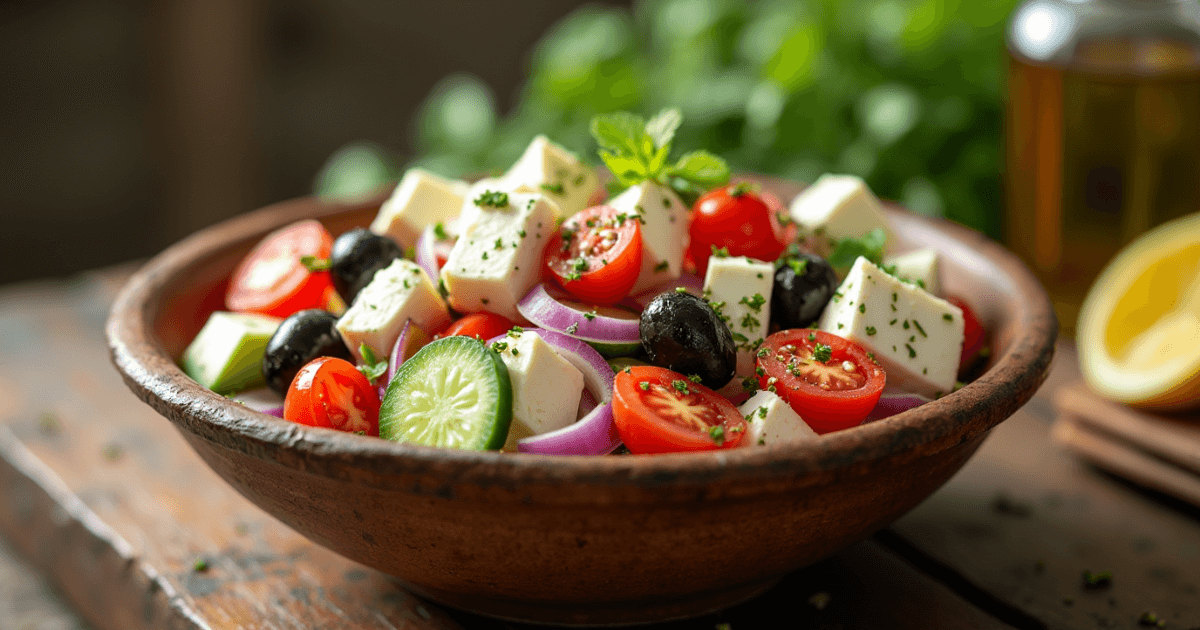Table of Contents
If you’ve ever tasted a Greek Salad Recipe on a summer vacation, you know that it’s a dish that’s as vibrant as it is delicious. The crispness of fresh cucumbers, the juiciness of ripe tomatoes, the richness of feta cheese, and the tang of Kalamata olives all come together in perfect harmony. But what if you could recreate that exact taste right in your own kitchen? Well, you can! In this article, you’ll learn how to make a classic Greek salad that’s not only simple and quick to prepare but also bursting with flavor.
Let’s dive into the world of Mediterranean cuisine and discover how to make the perfect Greek salad!
What Is a Greek Salad Recipe?
Before we dive into the recipe, it’s important to understand what makes a classic Greek salad unique. Greek salad, known as Horiatiki in Greece, is a rustic, vibrant dish made from fresh vegetables, olives, feta cheese, and a drizzle of olive oil. Unlike many salads, it doesn’t include lettuce. The vegetables are typically served in large chunks, allowing each ingredient to shine on its own.
This simple dish is a staple of Greek cuisine, celebrated for its fresh, natural flavors. Whether it’s served as a side dish or a main course, Greek salad is light yet satisfying, making it a popular choice for hot summer days.
Why Should You Make a Greek Salad?
Greek salad is not only delicious but also incredibly healthy. Packed with vitamins, fiber, and antioxidants from the vegetables, it’s a great choice if you’re looking to add more nutrient-dense foods to your diet. It’s low in calories but high in heart-healthy fats from olive oil and feta cheese. Plus, it’s naturally gluten-free and vegetarian, making it suitable for a variety of dietary preferences.
Essential Ingredients for a Classic Greek Salad
Making a truly authentic Greek salad starts with choosing the right ingredients. Fresh, high-quality produce is key to achieving that satisfying crunch and flavorful taste. Here’s a list of what you’ll need:

| Ingredient | Description | Why It’s Important |
|---|---|---|
| Cucumbers | Fresh, peeled and sliced | Adds crispness and a refreshing bite |
| Tomatoes | Ripe, juicy, and sweet | Contributes to the dish’s sweetness and moisture |
| Red Onion | Thinly sliced | Provides a sharp, slightly sweet contrast to the other ingredients |
| Kalamata Olives | Pitted and whole | Brings saltiness and a briny depth of flavor |
| Feta Cheese | Block of feta (not crumbled) | The star ingredient, providing creaminess and tang |
| Extra Virgin Olive Oil | Cold-pressed, high-quality olive oil | The base for the dressing that brings all the flavors together |
| Oregano (Dried) | Crushed | Adds an earthy, herbal aroma that’s quintessential to Greek flavor |
| Lemon Juice (Optional) | Freshly squeezed | Enhances the salad with acidity and freshness |
Tips for Choosing Ingredients
- Cucumbers: Go for thick-skinned cucumbers, as they hold their shape better in the salad. If you prefer a more refined texture, peel them lightly.
- Tomatoes: Always opt for the ripest tomatoes you can find. The flavor of fresh, ripe tomatoes makes a significant difference.
- Feta Cheese: Stick with a firm block of feta, ideally made from sheep’s milk, for the most authentic flavor. Crumbled feta doesn’t capture the true essence of a Greek salad.
- Olive Oil: The quality of the olive oil you use can elevate your salad to a whole new level. Invest in a good extra virgin olive oil that is cold-pressed for the best taste.
How to Prepare Your Classic Greek Salad
Now that you have all your ingredients ready, let’s go through the steps to make a traditional Greek salad.
Step 1: Slice the Vegetables
- Cucumbers: Start by slicing the cucumber into thick half-moon shapes. Don’t make them too thin, as you want the slices to retain some crunch.
- Tomatoes: Cut your tomatoes into wedges or large chunks. The idea is to leave the pieces big enough to hold their shape.
- Red Onion: Thinly slice the red onion. You can use a mandoline slicer for uniformity, but make sure the slices aren’t too thin, as you want them to stand up to the other ingredients.
Step 2: Assemble the Salad
- In a large mixing bowl, combine the cucumbers, tomatoes, and red onion slices.
- Add the Kalamata olives on top of the vegetables.
- For the feta cheese, take the block of feta and place it right on top of the salad. You can either leave it whole or cut it into large cubes, but avoid crumbling it—it’s meant to remain a substantial piece.
Step 3: Season the Salad
- Olive Oil: Drizzle a generous amount of extra virgin olive oil over the salad. The olive oil is an essential element that ties the whole dish together.
- Oregano: Sprinkle dried oregano over the salad. The key here is to use just enough so that it adds an aromatic flavor without overpowering the dish.
- Salt and Pepper: Season with salt and freshly ground black pepper to taste. Be careful not to over-salt, as the olives and feta cheese are already salty.
- Lemon Juice (Optional): For a little extra zing, squeeze some fresh lemon juice over the top. It balances the richness of the feta and olive oil.
Greek Salad Dressings: Traditional or Creative?
While the traditional Greek salad dressing is simple—just olive oil, lemon juice, and oregano—there are many ways to play around with the flavors if you want to get creative.
Traditional Greek Dressing
The classic Greek dressing focuses on enhancing the natural flavors of the ingredients. Here’s how you make it:
- Combine extra virgin olive oil, fresh lemon juice, salt, pepper, and dried oregano.
- Stir it together and pour it over the assembled salad. Toss gently, just enough to coat the vegetables and cheese with the dressing.
Creative Variations
- Balsamic Vinegar: Add a splash of balsamic vinegar to the dressing for a slightly sweet and tangy twist.
- Red Wine Vinegar: Some recipes use red wine vinegar instead of lemon juice for a sharper flavor.
- Honey or Mustard: If you want a touch of sweetness or extra tang, you can whisk in a teaspoon of honey or mustard into your dressing.
Tips for the Best Greek Salad
Achieving the perfect Greek salad is all about balance and technique. Here are some tips to make sure your salad turns out perfectly every time:
- Use Fresh Ingredients: Fresh vegetables are essential to a great Greek salad. The better the ingredients, the better the taste.
- Don’t Overmix: Greek salad should be served in a rustic, hearty style. Avoid over-mixing, which can break up the vegetables and feta.
- Chill Before Serving: Let your salad rest for a few minutes before serving. This allows the flavors to meld together and enhances the overall taste.
- Leave the Feta Intact: Don’t crumble the feta into the salad. The classic Greek salad features large chunks of feta that you can cut into as you eat.
How to Serve Your Greek Salad
Now that your Greek salad is ready, it’s time to think about how to serve it. Here are a few ideas:
Classic Greek Style
Serve the salad in a large bowl or individual plates, ensuring the feta block is left whole on top. This presentation is both traditional and visually appealing.
With Pita Bread
Greek salad pairs beautifully with warm pita bread. Use the bread to scoop up the fresh vegetables and feta, enhancing the meal’s Mediterranean flavor.
As a Light Meal
For a more filling meal, serve the salad alongside grilled chicken, fish, or lamb. The crispness of the salad is the perfect contrast to grilled meats, making it a versatile dish that works well with a variety of proteins.
Nutritional Benefits of Greek Salad
Greek salad is more than just a tasty dish—it’s a nutritional powerhouse. Here’s a quick breakdown of why it’s a great choice for your diet:
- Low in Calories: Greek salad is naturally low in calories, making it an excellent option for those watching their calorie intake.
- High in Fiber: The fresh vegetables are rich in fiber, promoting digestive health and keeping you feeling full.
- Heart-Healthy Fats: The olive oil used in Greek salad is full of monounsaturated fats, which are known for their heart-healthy properties.
- Packed with Vitamins: With vegetables like cucumbers, tomatoes, and onions, your Greek salad is full of vitamins and antioxidants that support overall health.
(FAQ)
What makes a Greek salad different from other salads?
Greek salad differs from many other salads because it doesn’t include lettuce. It’s centered around fresh vegetables, olives, and feta cheese, and seasoned with olive oil, lemon juice, and oregano. The result is a hearty, flavorful dish that’s perfect for summer.
Can I use other cheeses instead of feta in a Greek salad?
While feta is the traditional cheese, you can substitute it with other crumbly cheeses like ricotta salata or mild goat cheese. However, the taste won’t be quite the same as the tangy, creamy flavor of traditional feta.
Can I make a Greek salad ahead of time?
Greek salad is best enjoyed fresh, but you can prep the ingredients ahead of time.

